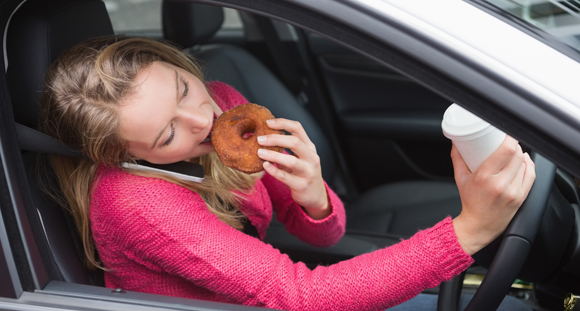Guard against distracted driving from eating while driving
13/10/2016 00:00:00by Paul Fincham13/10/2016 00:00:00Guard against distracted driving from eating while drivingBluedrop Services


Everyone knows the dangers of using a mobile phone whilst driving, but eating and drinking behind the wheel can cause just as much distraction affecting your reaction times. There have been three main types of distracted driving identified; a visual distraction that causes you to take your eyes off the road, a manual distraction that causes you to take your hands off the wheel or a cognitive distraction where you take your mind off what you are doing.
It is important to know that distracted driving is not just limited to the heavily publicised mobile phone usage and other activities can include eating while driving, drinking, using in-vehicle technology, controlling children and pets, reaching for something, grooming or external roadside diversions. Distractions of eating and drinking whilst driving is also something that hugely affects many businesses and their fleet insurance. Long working days and travelling from meeting to meeting, or makinging long haul deliveries do not help.
Recent studies on eating and drinking whilst driving
A recent study by Brunel University discovered that drinking and eating while driving actually doubles your likelihood of being in a car crash, and in fact around 53% of the 3000 drivers surveyed admitted to consuming food or drink whilst driving. 7% admitted to using a mobile phone whilst driving, 6% applying make-up, 11% preparing for meetings, and 12% admitted to smoking behind the wheel.
Another recent US study by the Insurance Institute for Highway Safety found that drivers between the age of 40 and 50 were observed to be eating and drinking more than other age groups whilst driving. They also found that a larger proportion of drivers were eating and drinking when they were alone in the car rather than with others and earlier in the day.
Penalties for driving without due care and attention
Whilst eating when driving is not in itself a crime, you can be prosecuted under an alternative charge of driving without due care and attention (CD10). Drinking or eating while driving is as much of a serious distraction as driving under the influence of alcohol.
If convicted of driving without due care and attention fines can be applied depending on the severity of the offence and between three and nine penalty points applied to your driver’s licence. There have even been cases recently reported of drivers being convicted for peeling a banana whilst sat in static traffic, and the issue of driving without due care and attention has been seen to be gaining greater prominence and attention from the police.
Increased fleet insurance premiums as a result of drinking and eating while driving
Insurance companies will usually apply higher premiums to a driver that they consider to have an increased risk factor. Unfortunately this means that those convicted of a CD10 offense will suffer increased insurance premiums, affecting your business fleet insurance. Whilst it is of major importance to protect the safety of your drivers and other road users, you also need to be thinking of the business costs and in addition to this any unwanted bad press.
How to prevent distracted driving accidents within your fleet
Ultimately eating while you drive, or doing any other secondary activity while driving, is going to be distracting. Firstly it is important to relay the information on distracted driving to your fleet drivers and to project a zero tolerance policy. In addition to this the use of improved vehicle safety technology will help to curtail the impact of many distracted driving incidents.
Technology such as AEB (Autonomous Emergency Braking) can reduce rear-end collisions by up to 40%. As with many safety features, the adoption of AEB technology within your fleet will also save you money on your fleet insurance premiums, with insurers recognising the significance of this technology in terms of reducing risk. Other safety features used to tackle distracted driving issues could include lane departure warning systems and general collision avoidance systems.
Return to blog menuWant to find out more about Bluedrop's Fleet Insurance?
Call our friendly team now for the right insurance cover - at the best price
+441489780491
Calls recorded for training and quality.



 Privacy and Cookie Policy
Privacy and Cookie Policy